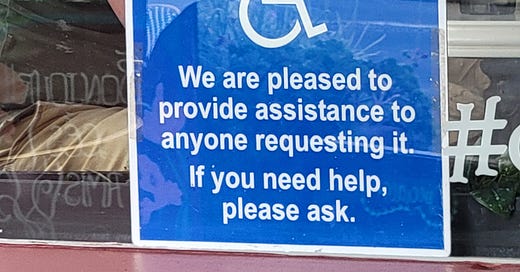Why offering "inclusion" isn't as inclusive as you might think
A conservation-relevant example from a local coffee shop
Last week, I posted this photo on my Notes here on Substack (and IG and LinkedIn) and suggested, without over-explaining, that there was a problem with this sign. A problem that is relevant to how we conceive of and implement "inclusion" or "inclusiveness" in any sector, including conservation.
Here's the explanation: Yes, this is, of course, less exclusionary than *not* having any sign. But let's put ourselves in the situation of someone who cannot climb the stairs of the cafe due to a disability. What does "asking for help" look like? What does it feel like? What will it lead to? There are important logistical and even emotional components to making access contingent on someone asking for it.
If we're in a wheelchair, do we just... wave our hands around until someone inside notices us? Wait outside until one of the servers happens to bring food out to the outside tables? And what is the help that is available to us? What accommodations can the cafe make? We don't really know, as the sign is pretty vague.
And then there's the emotional component of asking for help. If you pay any attention to disability justice advocates, you'll know that it is (sadly) not uncommon for them to be faced with unkind, dismissive, condescending, and even outright rude treatment from others in public. This includes when they ask for accommodations for their disability. So, not only is having to ask for help a question of logistics, but also: is it worth it? Will this lead to another unpleasant interaction where the disabled person's rights and dignity are disregarded? Will the very act of having to wave for help feel like yet another way of "standing out" when perhaps you're sick and tired of being stared at on a regular basis?
Back to conservation: I often see "inclusion" treated in an offhand manner (except when it's being poetically lauded in speeches, of course). There's a belief that offering something that looks like access equals the entire process of inclusion. As I highlighted in the post on the Moken: invitation is NOT inclusion. Offering the possibility of a more inclusive process is NOT going to magically result in inclusion.
The big missing piece? Empathy. Taking time and effort to actually think: what is the experience of this "inclusion" like for the people we are trying to include? How is this offer or outreach perceived, and what are the barriers - logistical, cultural, emotional, attitudinal, etc. - to responding to this offer?
I encourage everyone in conservation, particularly anyone who is not from an underrepresented identity, to inquire more deeply into your assumptions about what makes something "inclusive," even starting in your daily lives, like with my cafe example.
Granted, this cafe example is not particularly egregious; I've seen and heard of worse. It just happened to be a teachable moment that I encountered that day. But the cafe could and should do better, even without major renovations for better physical access. They could have a ringer or buzzer button outside at ground level that could be easily accessed. They could have a menu easily accessible outside, so people don't have to go inside just to look at it.
I recommend reading more about this, starting with this piece "For people with disabilities, asking for help carries hidden costs," by Andrew Pulrang in Forbes




